ASCOD Armored Vehicle Family (Austria / Spain)
The ASCOD (Austrian Spanish Cooperation Development) project started in the early eighties of the last century and was originally developed only by Austrian specialists. In 1982, the Austrian company Steyr-Daimler-Puch Spezialfahrzeug proactively began research on the appearance of a promising infantry fighting vehicle. Negotiations were held with the Greek, Norwegian and Swiss military to study the needs and requirements of European armies. In addition, in the mid-eighties, the Austrian army presented the requirements for promising infantry fighting vehicles. The authors of the project took into account the views of the military on promising technology and accordingly finalized it.
Experts Steyr-Daimler-Puch Spezialfahrzeug identified the main features of the appearance of a promising combat vehicle, but over time the work faced financial difficulties. Work on the initiative project led to significant expenses that no longer fit into the company's budget. At the same time, the Austrian armed forces refused to buy the proposed machines being developed, although they needed to replace the outdated Saurer 4K 4FA infantry fighting vehicles.
In connection with a similar situation, the Austrian company had to look for a foreign partner who could incur part of the development costs, as well as perform a certain amount of work. In 1988, Steyr-Daimler-Pooh signed a contract with the Spanish company Santa Barbara Sistemas. The signing of the contract led to the renaming of the project to ASCOD, and also gave him a serious push. Over the next few years, Spanish and Austrian engineers jointly completed the design, and soon began to build experimental equipment. Later, at the beginning of the two thousandth years, both companies that participated in the development of the ASCOD project became part of General Dynamics European Land Systems corporation.
In 1991, the construction of a prototype of a promising machine began. The assembly of the case and the corresponding units was undertaken by the Spanish experts. The Austrian side, in turn, took up the manufacture of a combat module. In order to simplify the project and reduce the cost of finished equipment, BMP ASCOD should have received a modified Pandur reconnaissance vehicle of the type SP-30. In this form, the prototype was first demonstrated to specialists, and then showed to potential customers.
It is interesting that in the course of development the most serious changes were made to the project. For example, during the design work, the combat mass of the prospective BMP increased markedly. The original terms of reference implied that this parameter would be at the level of 18 t. Over time, it was increased to 25 t, and the finished prototype weighed already 29 tons. Later, several other prototypes were built, which differed from the first one by some particular features.
The signing of a cooperation agreement between Steyr-Daimler-Puch and Santa Barbara Sistemas facilitated all the necessary work, but did not simplify the search for customers for promising technology. For example, in 1993, the first ASCOD prototype was sent to Norway, where it was tested. According to the results of the checks, the Norwegian Defense Ministry decided to purchase not the Austrian-Spanish development, but the Swedish vehicles of the CV90 family. A little later, the project was presented by the Spanish and Austrian military. This time they showed interest.
In 1994, the Spanish military conducted a test of the proposed prototype, and, convinced of its high performance, demanded that several pre-production machines be presented. According to the results of the trial operation of several new infantry fighting vehicles, a contract appeared for the supply of serial equipment. At the beginning of 1996, the Spanish armed forces ordered the ASCOD 144 units. The new BMP was put into service under its own name Pizarro.
The fate of the Austrian contract for the supply of armored vehicles was more difficult. Over time, the Austrian military leadership came to the conclusion that it was necessary to replace the existing equipment, but financial constraints did not allow ordering for several years. Only in 1999, a contract appeared for the supply of the first 112 machines to ASCOD. In the Austrian army, this technique received the additional designation Ulan.
The variants of the ACSOD machines for Austria and Spain have some differences, however, the same ideas and solutions lie at the heart of Lancer and Pizarro. In addition, two versions of armored vehicles have a very high degree of unification, and the differences relate to some parts, components and assemblies associated with the operation of certain troops, as well as with the standards of the armies.
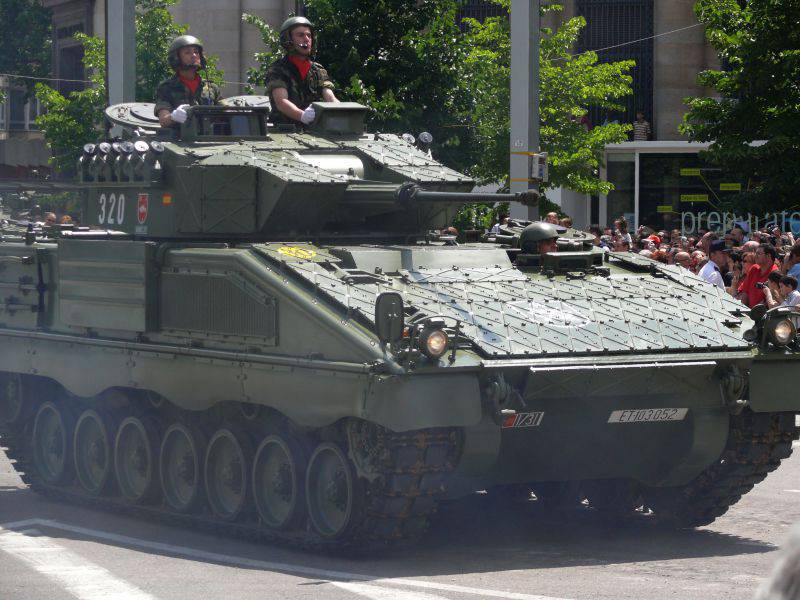
General view of the Spanish BMP ASCOD Pizarro. Clearly visible dynamic protection on the front sheet. Photo of Wikimedia Commons
ASCOD is a typical modern tracked infantry fighting vehicle. Machines of the family have a similar layout of internal units. The engine and transmission units occupy the front of the case, the driver is located next to them. Behind the power plant and the control department there is a fighting compartment with weapons, as well as with the commander and gunner. Feed given under the troop compartment. It is noteworthy that in the troop compartment of the Austrian "Lancer" eight fighters with personal weaponswhereas the Pizarro has only seven seats.
The body of combat vehicles of all versions is built from steel rolled armor plates. Own armor provides protection against 14,5-mm bullets when attacking from the front and all-view protection against 7,62-mm weapons. Also, the 76-mm smoke grenade launchers, which, if necessary, can be charged with fragmentation ammunition, are a unified protection element of the equipment.
Armored vehicles for the Spanish army received protection, reinforced by additional modules. Part of the surface of the steel hull is covered with SABBLIR dynamic protection blocks. With the help of such blocks, the probability of hitting a frontal projection with cumulative ammunition is reduced. Austrian ASCOD, in turn, received a combined additional armor type MEXAS. With its help, a significant increase in the level of protection is achieved: all-view protection against 14,5-mm weapons is provided, and frontal parts withstand hits of 30 caliber shells.
In front of the hull is the power plant. BMP for different customers differ in engine types. Thus, the Pizarro is equipped with an MTU SV-183 TE22 diesel engine with 600 horsepower, while the Ulan is equipped with an 720-strong MTU 8V-199-TE20 motor. Regardless of the type of engine, the machines are equipped with Renk HSWL 106C hydromechanical transmission.
As part of the chassis provides seven road wheels on each side. Skating rinks have an individual torsion suspension and are also equipped with additional shock absorbers. The drive wheels of the chassis are located in the front of the hull, in the immediate vicinity of the engine compartment. Guides, in turn, are placed in the stern. There are several supporting rollers under the upper branch of the track.
Due to the maximum unification, BMPs of the ASCOD family have similar dimensions and weight, and do not differ in terms of mobility. The total length of the two machines is 6,83 m, width - 3,64 m, height - 2,43 m. The Spanish car, due to some features, is slightly lighter than the Austrian: 26,3 t against 28 t.
Due to the relatively high power density (at least 21-22 hp per ton), ASCOD cars are able to reach speeds up to 70 km / h on the highway. The maximum speed in reverse is stated at the level of 35 km / h. Acceleration from 0 to 50 km / h in 14-15 seconds is provided. There is a possibility of crossing the ditches up to 2,3 m wide and lifting to the 950-mm wall. The machines cannot swim, but they are able to cross a ford to a depth of 1,2 m without preparation.
The BMP ASCOD tower is a further development of the Austrian combat modules of previous models. It is made from a set of armor plates of various sizes and shapes. The level of protection of the tower corresponds to the parameters of the hull. A characteristic feature of the tower is its location. To save a small passage connecting the control compartment and the landing compartment, the tower is shifted to the starboard. It provides two jobs for the commander and the gunner.
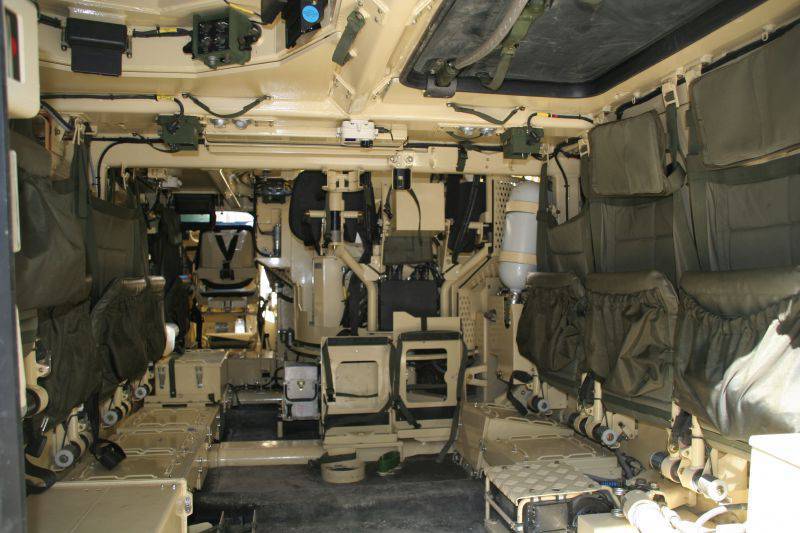
The interior of the troop compartment of the Ulan car overlooking the driver’s seat and the fighting compartment. Photo of Wikimedia Commons
The composition of weapons and special equipment of the two variants of the ASCOD machine has some differences. A common element is the automatic Mauser MK-30 / 2 X-gun caliber 30 mm with automatic gas, providing a rate of fire up to 770 shots per minute. The gun is equipped with a two-plane stabilizer with electric drives. The design of the tower provides circular guidance in the horizontal plane and vertical guidance from -10 ° to + 50 °. The gun has a double supply of ammunition, which allows you to quickly select the desired ammunition.
Additional armament depends on the type of BMP. The Spanish "Pizarro" is equipped with a coiled MG3 machine gun, the Austrian "Ulan" - FN MAG. Also, the size of the ammunition depends on the type of vehicle. The Spanish version of ASCOD carries 300 projectiles for an automatic cannon, while the ammunition load of an Austrian machine gun is divided into two parts. Ready for use 200 shells, another 205 are in the layouts inside the case. In addition, ASCOD Ulan has 600 cartridges for machine gun in the turret, and 1290 cartridges are stored in stacks.
The composition of fire control equipment was determined by the client countries in accordance with their requirements. For this reason, the Pizarro BMP is equipped with the Indra Mk-10 fire control system with combined day and night sights, a laser rangefinder and a digital ballistic computer. It was reported plans to introduce into the OMS new equipment with enhanced characteristics.
BMP for Austria received a fire control system from Kollsman, built using the MSA units tank SK-105 Kürassier. For guidance, the car received a combined day and night sight from Elbit. In both modes, this device provides up to 8x magnification. The signal from the optoelectronic system is displayed on the screens of the commander and gunner’s workstations.
The crew of both versions of the BMP ASCOD consists of three people: the driver, the commander and the gunner. Crew jobs are equipped with their own hatches in the roof of the hull and tower, as well as a set of viewing devices with the ability to use night vision systems. In the troop compartment is located 7 (Pizarro) or 8 (Ulan) seats for soldiers with weapons. For landing troops may use aft door or several hatches in the roof.
It should be noted, the Spanish order 144 armored vehicles meant the delivery of only 123 infantry vehicles. The remaining machines were ordered in the configuration of the command and staff. In 2004, the Spanish Ministry of Defense re-ordered the 212 Pizarro machines in several versions. 170 BMPs, 28 artillery reconnaissance vehicles, 8 repair and evacuation vehicles, 5 command-staff and 1 engineering machines were acquired. In process of preparation for production of new cars the Spanish military faced financial difficulties. Due to budget cuts, the order had to be reduced to all necessary modifications to 117 machines. Deliveries of this technology were carried out in 2011-15.
Until the middle of the last decade, the Austrian armed forces received the 112 BMP ASCOD Ulan in basic and training versions and, as far as we know, no longer placed new orders. Exact information about plans to acquire such equipment in the future is not yet available.
Spanish specialists have developed several modifications of the basic ASCOD Pizarro, which were mass-produced. The main option was the Pizarro VCI / C - combat "cavalry" infantry machine. The Pizarro VCPC command and control vehicle is distinguished by the absence of a complete set of places for paratroopers, instead of which special equipment is installed for communication and control of troops. The VCOAV reconnaissance vehicle is equipped with an expanded set of surveillance tools, and the evacuation and engineering VCREC and VCZ carry a set of special equipment designed for solving certain tasks.
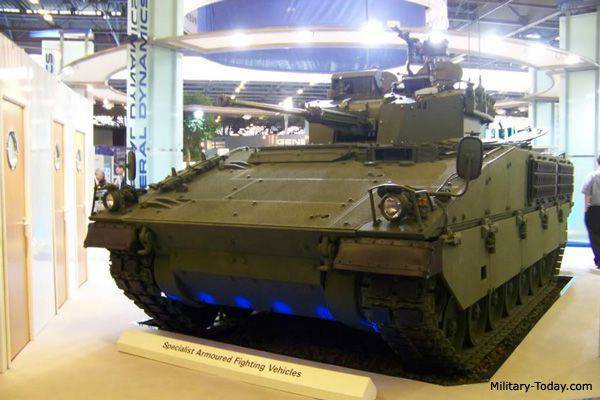
Upgraded machine ASCOD 2. Photo Military-today.com
There is also a training option "Pizarro", intended for the training of driver-mechanics. In this case, instead of a tower, a large cabin for an instructor with a developed frontal and side glazing is mounted on the hull. A certain amount of such equipment was supplied to both Spain and Austria.
General Dynamics, which included both ASCOD project developers at the beginning of the two thousandth, continued the development of this technology. The result was a BMP project, called ASCOD 2. The upgraded machine differs from the basic version by a more powerful MTU engine V8 199 T21 (805 hp), a modified transmission and new control systems. Due to the use of new protection systems, the normal mass of the machine is increased to 30 t. Additional protection blocks can increase this parameter to 40-42 t. The composition of weapons and fire control systems can be determined in accordance with the wishes of the customer.
Over the past few years, British military experts have been working on a program for the development of the armed forces, which includes several projects to create new armored vehicles. In 2010, the British Department of Defense decided that prospective armored vehicles for infantry should be based on the ASCOD BMP. It is assumed that in the foreseeable future several new armored vehicles for various purposes (Scout SV or Ajax family) will be developed, which will allow the British army to replace the existing equipment of obsolete types. The first cars of the new type are planned to be received in 2017 year, and by the end of the decade the re-equipped units will be fully ready for service.
Work on the project ASCOD started in the early eighties, but, despite the great age, it seems that it still retains its relevance. At the beginning of the last decade, an updated version of the ASCOD 2 project was created, which took into account the peculiarities of recent armed conflicts. According to the results of comparison with other proposals, he was chosen as the basis for promising British technology, which will begin service only at the end of the current decade. Thus, all ASCOD vehicles will maintain their place in the armed forces of several countries over the next decades. It seems that the Austrian and Spanish engineers managed to create a successful project of a universal armored vehicle, the modernization potential of which has not yet been exhausted.
On the materials of the sites:
http://army-technology.com/
http://military-today.com/
http://gdels.com/
http://armyrecognition.com/
http://globalsecurity.org/
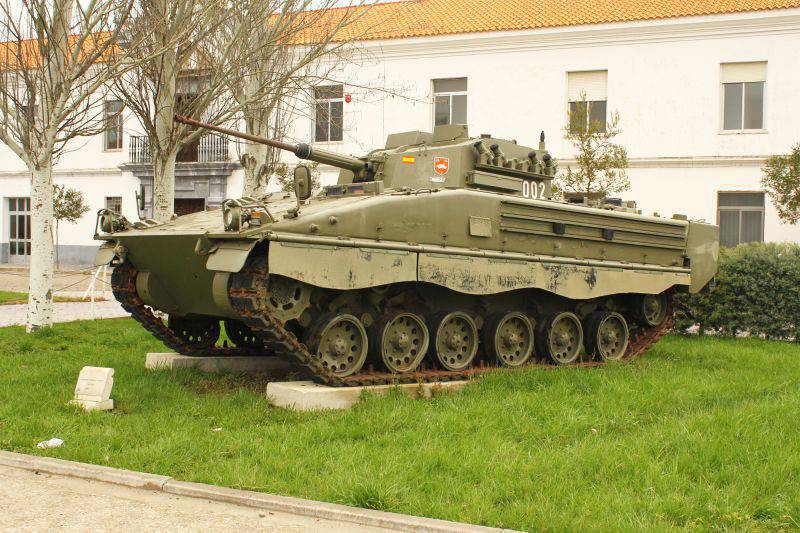
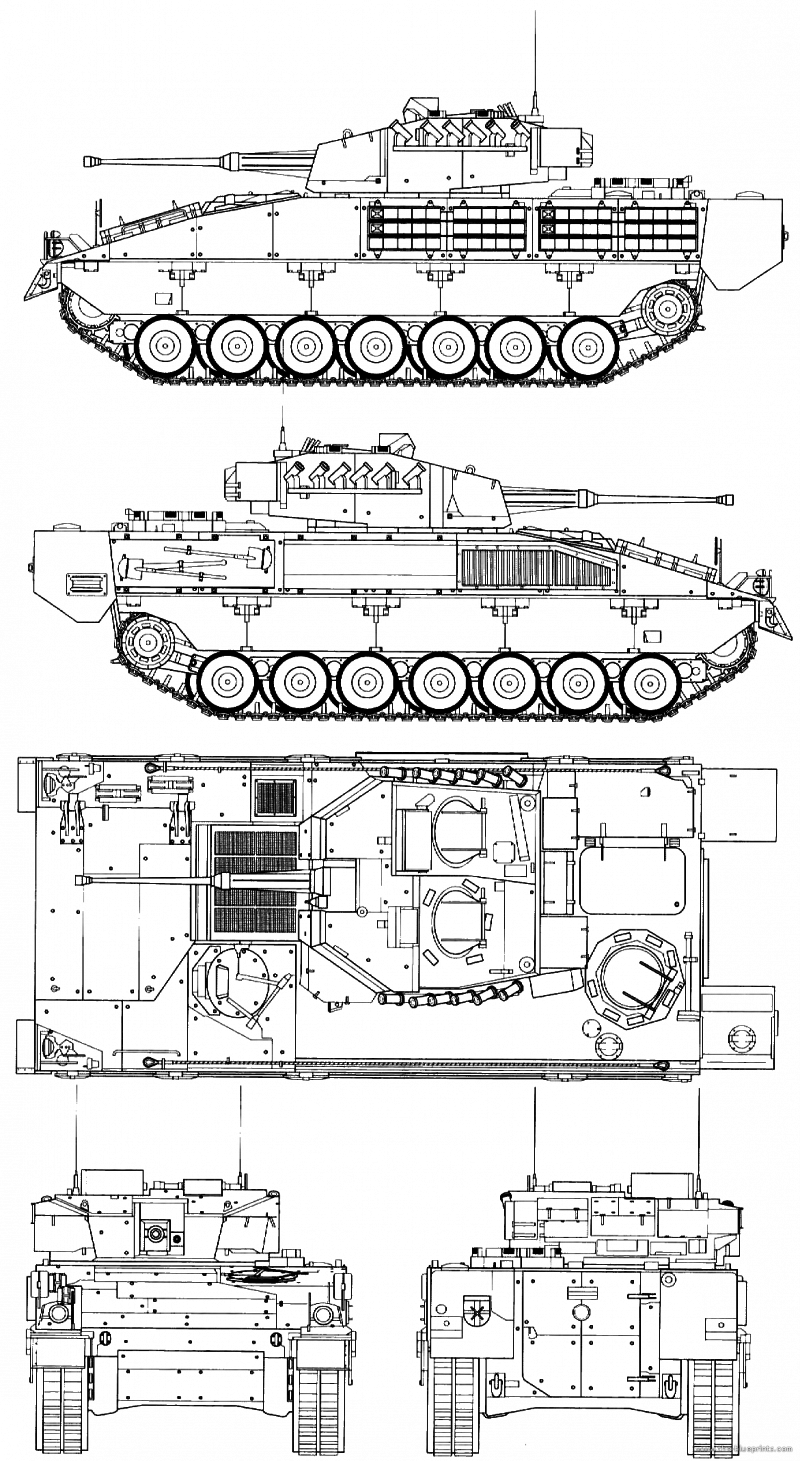
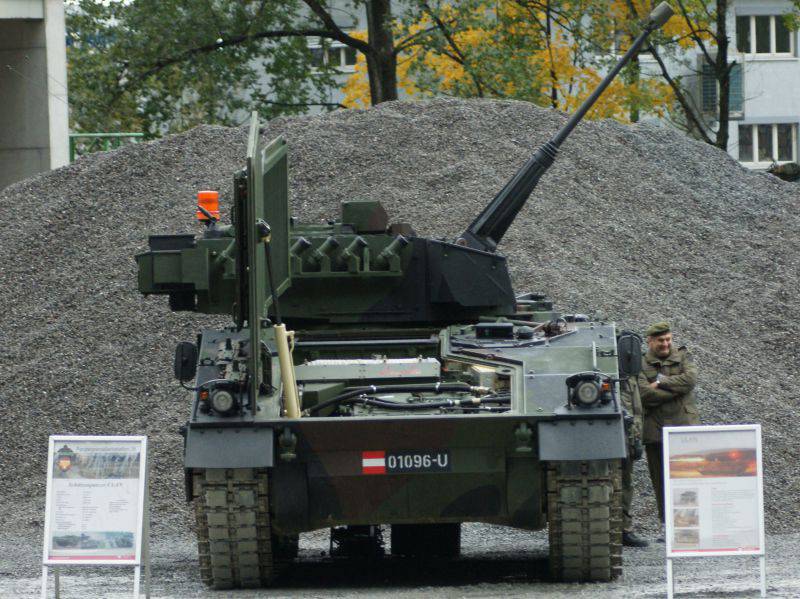
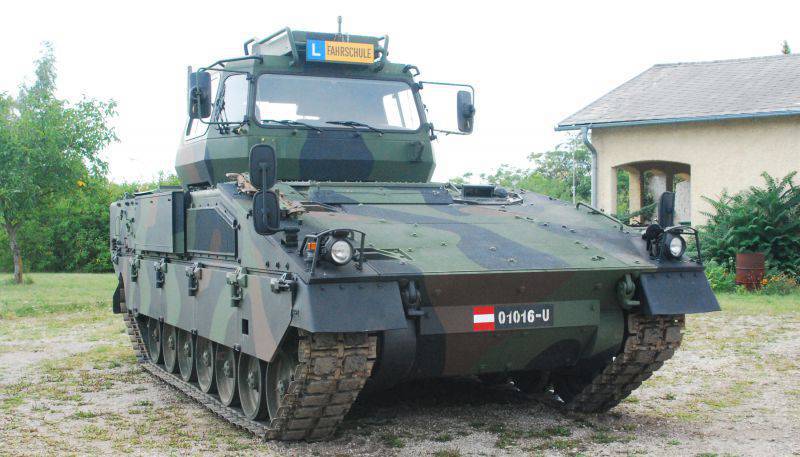
Information